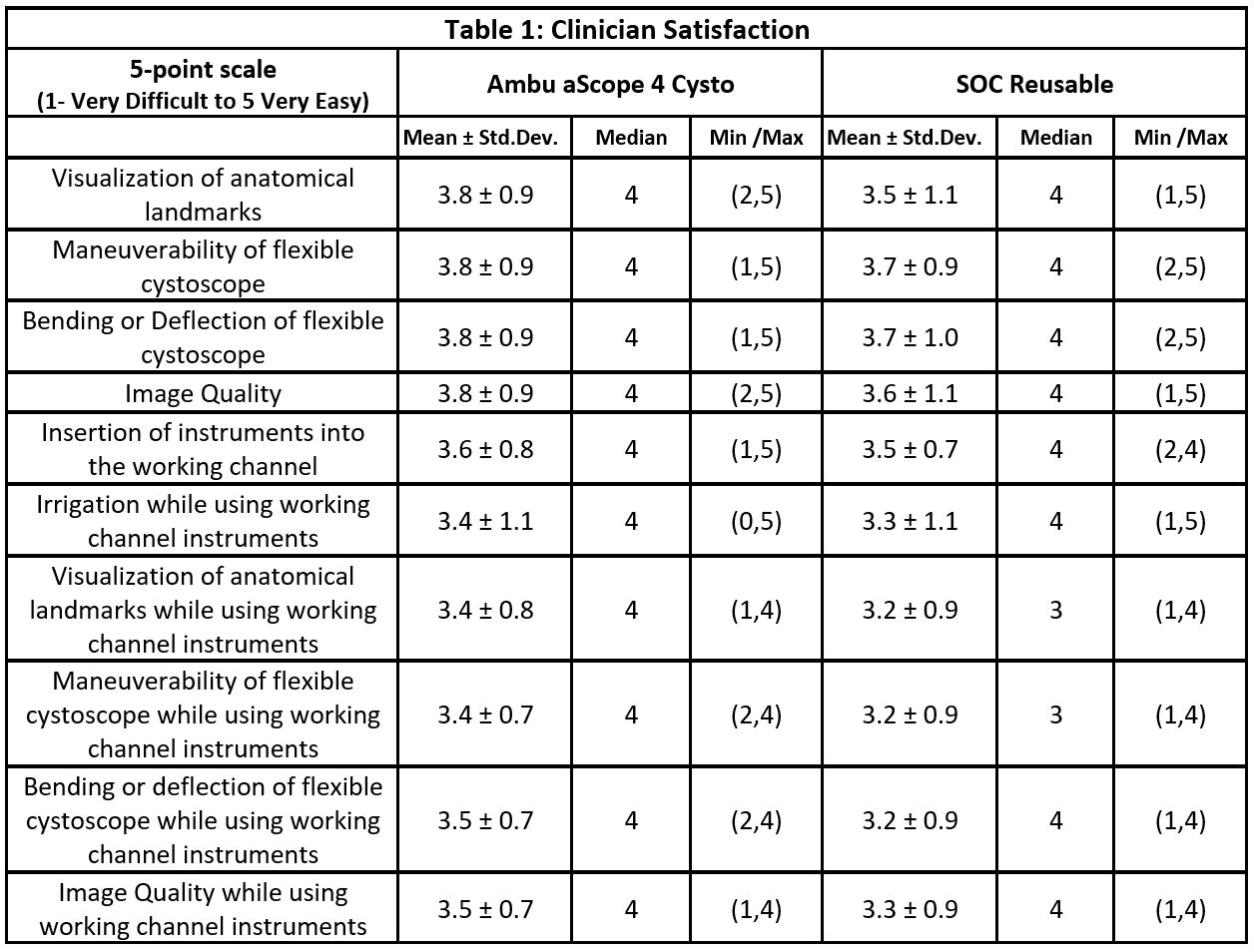Back
Introduction: Reusable cystoscopes are associated with risks of cross-contamination, need for chemical reprocessing, mechanical breakdown, manpower for cleaning and maintenance costs. A sterile, single use cystoscope may reduce or eliminate the source of these infections, while also decreasing exposure to reprocessing chemical agents. This multicenter, prospective randomized trial compared single-use vs. reusable endoscope for removal of ureteral stents.
Methods: The evaluation of a single-use cystoscope (Ambu A/S) was completed in a prospective, randomized, dual-arm post-market clinical trial to directly compare its performance to standard of care (SOC) flexible reusable cystoscopes in the removal of ureteral stents in an outpatient setting. 102 patients were evaluated from baseline through day 10 post-procedure at three investigative sites. The primary endpoint was the success rate of the stent removal procedures, delineated by single-use or reusable cystoscope. Secondary endpoints included time from preparation to disposal or reprocessing preparation, urologic adverse events 0-10 days, and a post-procedure clinician satisfaction survey.
Results: There were 102 subjects, randomized 1:1 between the single-use scope and SOC reusable scope. The successful stent removal rate was 51/51 for SOC group and 50/51 for single-use group (p=1.00). One patient required the conversion to a reusable scope due to a grasper passage issue with the index scope. There was no statistical difference in the time from scope insertion to procedure completion between the study arms. Median time from prep for the procedure to disposal/prep for reprocessing was 611 sec. for the single-use and 1105 sec. for the reusable (p=0.00). Reprocessing time was not evaluated in study. The 5-point survey demonstrated no difference in clinician satisfaction between both arms across all parameters addressed, as seen in the Clinician Satisfaction Table. There was no difference in adverse events between arms and no device causal attribution for any adverse events reports. One serious adverse event required hospitalization for infection in the SOC arm.
Conclusions: The RCT of single-use cystoscopes vs. reusables showed comparable device success with significant time savings for single-use and equal clinician satisfaction. SOURCE OF
Funding: Ambu USA sponsored this trial.

Moderated Poster Session
Session: MP26: Surgical Technology & Simulation: Instrumentation & Technology I
MP26-20: Randomized Trial of Single-Use versus Reusable Cystoscope for Ureteral Stent Removal
Saturday, April 29, 2023
7:00 AM – 9:00 AM CST
Location: S403

Brett A. Johnson, MD (he/him/his)
Assistant Professor
UT Southwestern
Poster Presenter(s)
Introduction: Reusable cystoscopes are associated with risks of cross-contamination, need for chemical reprocessing, mechanical breakdown, manpower for cleaning and maintenance costs. A sterile, single use cystoscope may reduce or eliminate the source of these infections, while also decreasing exposure to reprocessing chemical agents. This multicenter, prospective randomized trial compared single-use vs. reusable endoscope for removal of ureteral stents.
Methods: The evaluation of a single-use cystoscope (Ambu A/S) was completed in a prospective, randomized, dual-arm post-market clinical trial to directly compare its performance to standard of care (SOC) flexible reusable cystoscopes in the removal of ureteral stents in an outpatient setting. 102 patients were evaluated from baseline through day 10 post-procedure at three investigative sites. The primary endpoint was the success rate of the stent removal procedures, delineated by single-use or reusable cystoscope. Secondary endpoints included time from preparation to disposal or reprocessing preparation, urologic adverse events 0-10 days, and a post-procedure clinician satisfaction survey.
Results: There were 102 subjects, randomized 1:1 between the single-use scope and SOC reusable scope. The successful stent removal rate was 51/51 for SOC group and 50/51 for single-use group (p=1.00). One patient required the conversion to a reusable scope due to a grasper passage issue with the index scope. There was no statistical difference in the time from scope insertion to procedure completion between the study arms. Median time from prep for the procedure to disposal/prep for reprocessing was 611 sec. for the single-use and 1105 sec. for the reusable (p=0.00). Reprocessing time was not evaluated in study. The 5-point survey demonstrated no difference in clinician satisfaction between both arms across all parameters addressed, as seen in the Clinician Satisfaction Table. There was no difference in adverse events between arms and no device causal attribution for any adverse events reports. One serious adverse event required hospitalization for infection in the SOC arm.
Conclusions: The RCT of single-use cystoscopes vs. reusables showed comparable device success with significant time savings for single-use and equal clinician satisfaction. SOURCE OF
Funding: Ambu USA sponsored this trial.
